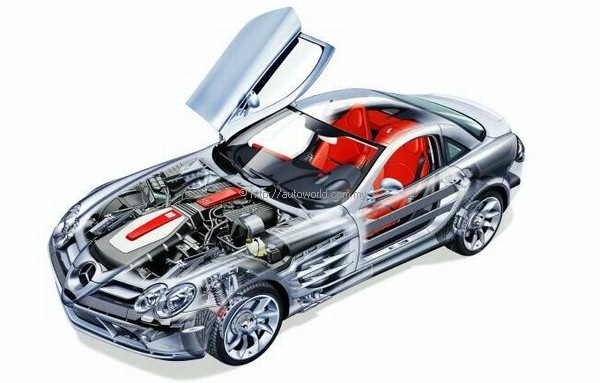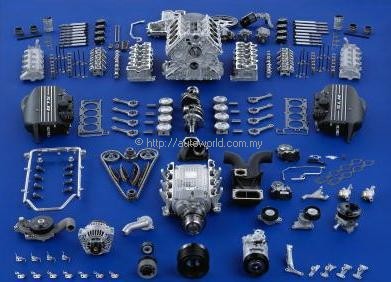The Technology of the Mercedes-Benz SLR McLaren
After tantalising the world with the first pictures of its exclusive SLR McLaren, Mercedes-Benz has now released the technical details of the supercar which is most definitely entitled to carry those three letters of hallowed status.
Just like its legendary predecessor of 1955, this 21st century SLR incorporates new technological developments which are ahead of their time. The evidence is under the bonnet: a Mercedes-AMG V8 powerplant. With its 5.5-litre displacement and screw-type compressor, the engine develops peak output of 460 kW/626 hp and delivers its maximum torque of 780 Nm from 3250 rpm – a figure which remains constant across a broad engine speed range of up to 5000 rpm.
With this kind of power, the SLR McLaren is said to be capable of sprinting from 0 to 100 km/h in 3.8 seconds and from a standing start, it will take just 28.8 seconds to reach 300 km/h. Unlimited, the top speed is expected to be as high as 334 km/h.
In the interests of optimum weight distribution, optimum dynamic handling and high stability on braking, the Mercedes-Benz SLR McLaren has a front mid-engined design. The V8 powerplant is mounted on a robust aluminium frame and has a low installation position. Water-type charge-air cooling, three valves per cylinder, dry sump lubrication and four metal catalytic converters are further special features of this powerful engine – an engine which already meets stringent Euro-4 exhaust gas regulations which are not due to come into force until 2005.
The 5-speed automatic transmission, fitted as standard, is also designed for high performance. It allows the driver to choose between three programs, letting him or her determine the shift speed individually. When “Manual” is selected, the five gears can either be shifted using buttons on the steering wheel or using the selector lever’s Touchshift function. In manual mode, the driver can select between three shift stages – “Sport”, “SuperSport” and “Race” – significantly shortening the shift times still further for an even sportier drive.
The bodyshell of the car is also distinctly high-tech. Along with the front and rear structure and the passenger cell, the swing-wing doors and the bonnet, it is made entirely from carbon fibre composite. This lightweight yet extremely rigid material originated in the aeronautical and space industries and has also proven its benefits in today’s Formula 1 race cars. The weight advantage of the high-tech material over steel is around 50%.
In addition to this, carbon fibres, on impact, are characterised by four to five times higher energy absorption than steel or aluminium. Mercedes-Benz exploits these qualities by inserting two 620-mm longitudinal members made from carbon fibre in the front structure of the new SLR. These absorb the entire energy of the crash in a head-on collision without exceeding tolerable deceleration values for the occupants. In an impact the fibres of these elements shred from front to rear with precisely calculated deformation behaviour, ensuring constant deceleration.
This makes the SLR the world’s first series-produced car to have a front crash structure made entirely from carbonfibre. The carbon fibre longitudinal members each weigh just 3.4 kgs.
The passenger cell of the high-performance sports car is also made entirely from this high-tech material. In a head-on, side-on or rear-end collision, it offers the passengers an extremely rigid, safe survival zone. At the rear, two internal longitudinal members made from laminated carbon fibre and a robust cross member take on the task of energy absorption in the event of a crash – as a rule the passenger cell remains structurally unaffected.
Adaptive front airbags which deploy in two stages depending on the severity of the accident, newly developed sidebags which protect the head, plus belt tensioners and belt force limiters all form part of the new SLR’s occupant protection system.
The brake discs are also made from a high-tech material which meets the highest of standards. Here, Mercedes-Benz engineers chose carbon fibre-reinforced ceramic to achieve outstanding performance, temperature-resistance and longevity. Thanks to the highly robust material, the SLR’s large brake discs allow maximum deceleration of up to 1.3 g – a top value in a series-produced car. At the front axle alone, a total brake pad area of 440 square cm is available.
Further features of the new SLR include Sensotronic Brake Control (the electro-hydraulic braking system), the Electronic Stability Program (ESP), automatic tyre pressure monitoring, 18-inch wheels and aluminium suspension which bears the signature of experienced race car constructors – all of which create the necessary criteria for perfect dynamic handling and excellent driving safety.
The SLR’s suspension meets every criteria a discerning car driver would expect to find in a GT with the Mercedes star. The axle design bears the signature of experienced racing car developers, with double wishbone suspension at the front and rear. The lower struts are arranged so that, as the springs compress and when cornering at speed, the wheels have a negative camber. This ensures the best possible contact with the road in every situation. At the same time the axle technology prevents the front of the car from diving when braking heavily and the rear from diving when accelerating.
Aluminium was the key material for the developers of the suspension. The wishbones are made from forged aluminium, while the wheel mounts are cast in aluminium. In addition to a whole series of other advantages over conventional steel designs, the lightweight nature of the material allows the suspension to react significantly faster and to respond more sensitively.
The relatively long wheelbase (at 2700 mm) also contributes to the SLR’s exemplary handling and makes itself noticed above all in the car’s exemplary directional stability, while the large track width, combined with the low centre of gravity, allows high cornering speeds.
Springing/damping combinations at the front and rear axle and an anti-roll bar at the front complete the suspension structure. The anti-roll bar is positioned above the front axle and – as in Formula 1 – is controlled via rocker arms. This means that it does not take up any installation space which could impair the smooth line of the underbody – a vital factor when it comes to the sports car’s outstanding aerodynamic properties.
The speed-sensitive rack-and-pinion power steering also corresponds with the intelligent lightweight concept. In comparison with other steering systems, this design is characterised by a significantly lower weight. Thanks to its low installation position in front of the engine and the gear ratio of 12.6, the steering system responds directly to the driver’s commands and carries them out with high precision. The three-spoke steering wheel has a diameter of 380 mm and is fitted with an electric motor which allows it to be positioned to suit the individual driver. It can be adjusted by 60 mm for reach, and the height of the steering wheel can be varied by 2.7 degrees.
The breathtaking performance of the SLR is also aided by an adaptable spoiler – known as the airbrake – in the bootlid. If the driver steps heavily on the brake pedal, the rear spoiler rises to an angle of 65 degrees, boosting the braking effect by producing greater aerodynamic drag. When braking from high speeds, it is claimed to give the SLR outstanding stability.
In most situations the electronics control the airbrake as required. However, the driver can also opt to take control of the adjustments using the switch in the centre console, manually raising the rear spoiler up to an angle of 30 degrees.
 |



























